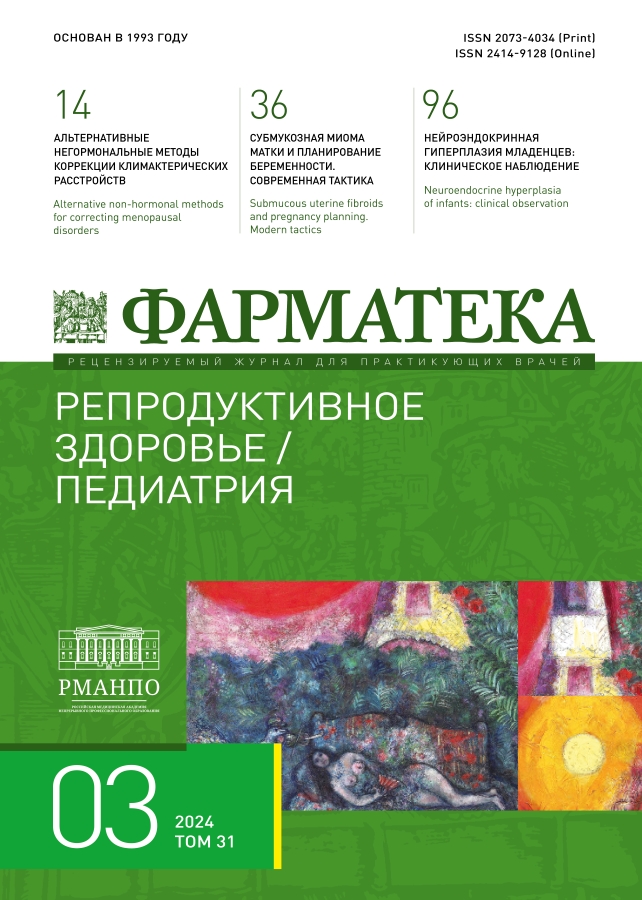Гиперсенситивный пневмонит у детей. Клинический опыт
- Авторы: Сергиенко Д.Ф.1, Башкина О.А.1, Кузнецова Т.М.2
-
Учреждения:
- Астраханский государственный медицинский университет
- Областная детская клиническая больница им. Н.Н. Силищевой
- Выпуск: Том 31, № 3 (2024)
- Страницы: 83-88
- Раздел: Оригинальные статьи
- URL: https://journals.eco-vector.com/2073-4034/article/view/634927
- DOI: https://doi.org/10.18565/pharmateca.2024.3.83-88
- ID: 634927
Цитировать
Полный текст
Аннотация
Введение. Наиболее распространенной формой интерстициальных заболеваний легких у детей является гиперсенситивный пневмонит (ГП). Изучение клинико-эпидемиологических особенностей, вариабельности этиологических факторов, подходов к терапии заболевания является актуальной проблемой детской пульмонологии.
Цель исследования: проанализировать особенности клинической картины и вариабельность специфических аллергенов при ГП у детей.
Методы. Обследованы 13 детей с ГП на базе пульмонологического отделения ГБУЗ АО «ОДКБ им. Н.Н. Силищевой» в период с 1 января 2022 по 30 апреля 2023 г. Диагноз основывался на характерной клинической картине, результатах лучевой диагностики и функциональных дыхательных тестов, а также на истории контакта с потенциально провоцирующим антигеном с последующим иммунологическим обследованием.
Результаты. За период наблюдения выявлены 13 больных ГП. Клиническая картина заболевания характеризовалась типичными проявлениями в виде признаков интоксикации, дыхательной недостаточности, крепитации при аускультации легких, при этом степень выраженности дыхательной недостаточности была ассоциирована с возрастом пациентов. У ряда больных выявлена коморбидная патология в виде бронхиальной астмы и аллергического ринита. У обследованных детей наиболее значимыми факторами, вызывающими ГП, были грибковые антигены и аллергены птиц. Основной стратегией лечения ГП считалось устранение пускового фактора и использование в терапии системных глюкокортикостероидов, что способствовало благоприятному исходу заболевания при остром течении и выходу в ремиссию при хроническом.
Выводы. Проведенное исследование демонстрирует, что число диагностированных случаев в регионе увеличивается. ГП дебютирует в первые годы жизни, характеризуется гетерогенностью клинической картины в различные возрастные периоды детства с вариабельностью причинно-значимых агентов, однако лидирующие позиции – за грибковыми аллергенами и аллергенами птиц.
Полный текст
Об авторах
Диана Фикретовна Сергиенко
Астраханский государственный медицинский университет
Автор, ответственный за переписку.
Email: gazken@rambler.ru
ORCID iD: 0000-0002-0875-6780
д.м.н., профессор кафедры факультетской педиатрии
Россия, АстраханьО. А. Башкина
Астраханский государственный медицинский университет
Email: gazken@rambler.ru
ORCID iD: 0000-0003-4168-4851
Россия, Астрахань
Т. М. Кузнецова
Областная детская клиническая больница им. Н.Н. Силищевой
Email: gazken@rambler.ru
Россия, Астрахань
Список литературы
- Лев Н.С. Гиперчувствительный пневмонит в детском возрасте. Медицинский совет. 2015;15:86–7. [Lev N.S. Hypersensitivity pneumonitis in childhood. Med Council. 2015;15:86–7. (In Russ.)].
- Авдеев С.Н. Гиперчувствительный пневмонит. Пульмонология. 2021;31(1):88–99. [Avdeev S.N. Hypersensitivity pneumonitis. Pulmonology. 2021;31(1):88–99. (In Russ.)]. doi: 10.18093/0869-0189-2021-21-1-88-99.
- Selman M., Pardo A., King T.E. Hypersensitivity pneumonitis: insights in diagnosis and pathobiology. Jr Am J Respir Crit Care Med. 2012;186(4):314–24. doi: 10.1164/rccm.201203-0513CI.
- Лев Н.С., Мизерницкий Ю.Л. Клинические варианты интерстициальных болезней легких в детском возрасте. М., 2021. 368 с. [Lev N.S., Mizernitsky Yu.L. Clinical variants of interstitial lung diseases in childhood. M., 2021. 368 p. (In Russ.)].
- Клинические рекомендации. Профессио-нальный экзогенный аллергический альвеолит. 2023. [Clinical recommendations. Professional exogenous allergic alveolitis. 2023.
- Лев Н.С., Шмелев Е.И., Розинова Н.Н. Гиперчувствительный пневмонит. В кн.: Орфанные заболевания легких у детей. Под ред. Н.Н. Розиновой, Ю.Л. Мизерницкого. М., 2015. С. 57–66. [Lev N.S., Shmelev E.I., Rozinova N.N. Hypersensitivity pneumonitis. In the book: Orphan lung diseases in children. Ed. N.N. Rozinova, Yu.L. Mizernitsky. M., 2015. Р. 57–66. (In Russ.)].
- Fernandez Perez E.R., Kong A.M., Raimundo K., et al. Epidemiology of hypersensitivity pneumonitis among an insured population in the United States: a claims-based cohort analysis. Ann Am Thorac Soc. 2018;15:460–9.
- Morell F., Villar A., Ojanguren I., et al. Hypersensitivity pneumonitis and (Idiopathic) pulmonary fibrosis due to feather duvets and pillows. Arch Bronconeumol. 2021;57:87–93. doi: 10.1016/j.arbres.2019.12.003.
- Овсянников Д. Ю., Беляшова М.А., Бойцова Е.В. и др. Нозологическая структура и особенности интерстициальных заболеваний легких у детей первых 2 лет жизни: результаты многоцентрового исследования. Неонатология: новости, мнения, обучение. 2018;6(2). [Ovsyannikov D.Yu., Belyashova M.A., et al. Nosological structure and features of interstitial lung diseases in children of the first 2 years of life: results of a multicenter study. Neonatology: news, opinions, training. 2018;6(2). (In Russ.)].
- Таточенко В.К. Экзогенный аллергический альвеолит. В кн: Болезни органов дыхания у детей. Практическое руководство. 2-ое изд., испр. 2015. С. 304–9. [Tatochenko V.K. Exogenous allergic alveolitis. In the book: Respiratory diseases in children. Practical guide. 2nd ed., rev. 2015. Р. 304–9. (In Russ.)].
- Спичак Т.В. Экзогенный аллергический альвеолит. В Руководстве «Рациональная фармакотерапия детских заболеваний». Под ред. А.А. Баранова, В.В. Володина, Г.А. Самсыгиной. М., 2007. С. 521–7. [Spichak T.V. Exogenous allergic alveolitis. In the Guide “Rational pharmacotherapy of childhood diseases”. Ed. A.A. Baranova, V.V. Volodina, G.A. Samsygina. M., 2007. Р. 521–7. (In Russ.)].
- Capristo C., Campana G., Galdo F., et al. Eosinofilic lung diseases and hypersensitivity pneumonitis. In: ERS/handbook Paediatric Respiratory Medicine 1st Edition. Editors E. Eber and F. Midulla 2013: European Respiratory Society; Р. 610–8.
- Hirschmann J.V., Pipavath S.N.J., Godwin J.D. Hypersensitivity Pneumonitis: A Histirical, Clinical and Radiologic Review. RadioGraphics. 2009;29:1921–038.
Дополнительные файлы











